1998 CHEVROLET PRIZM oil temperature
[x] Cancel search: oil temperaturePage 240 of 364
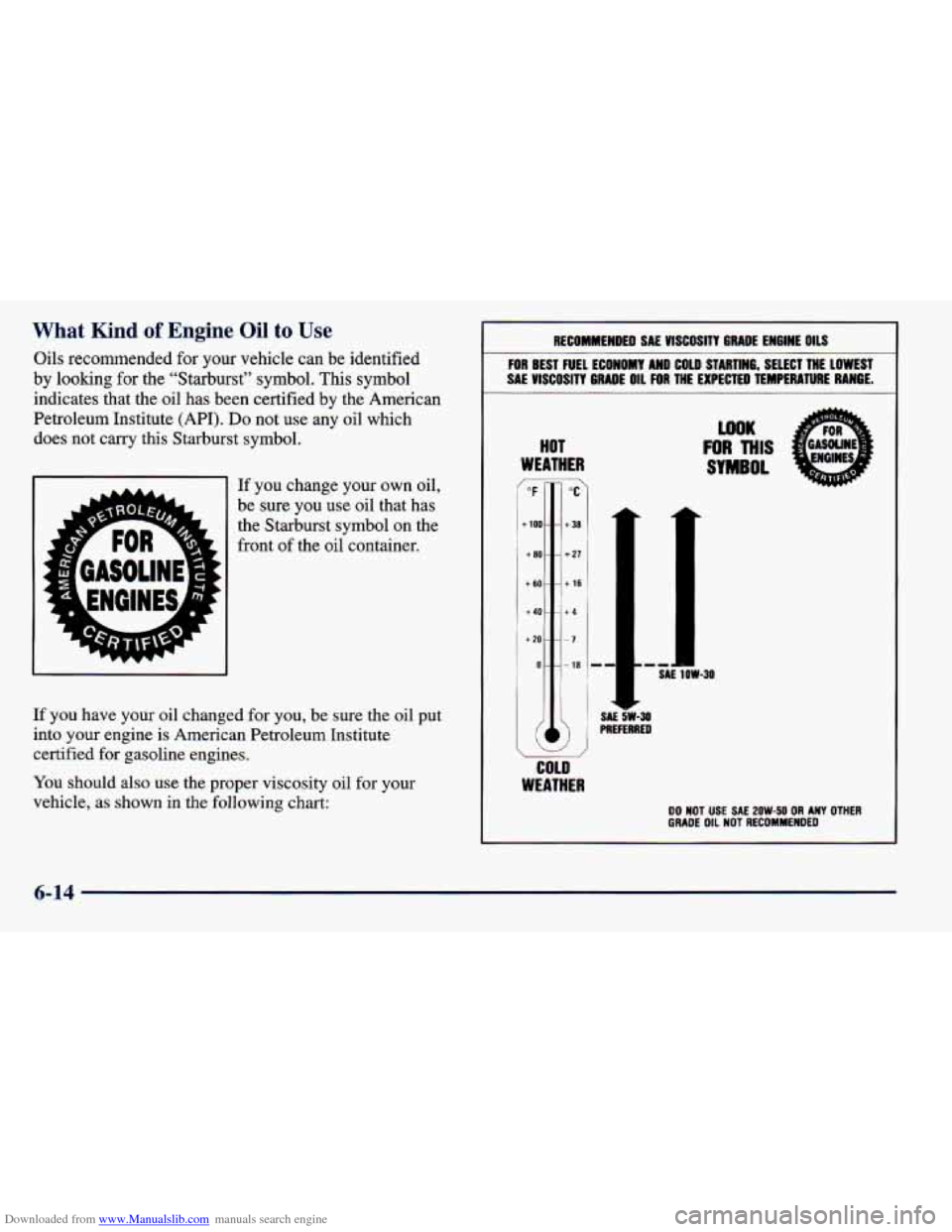
Downloaded from www.Manualslib.com manuals search engine What Kind of Engine Oil to Use
Oils recommended for your vehicle can be identified
by looking
for the “Starburst” symbol. This symbol
indicates that the oil has been certified by the American
Petroleum Institute (API).
Do not use any oil which
does not carry this Starburst symbol.
If you change
your own oil,
be sure you use oil that has
the Starburst symbol
on the
front
of the oil container.
If you have your oil changed for you, be sure the oil put
into
your engine is American Petroleum Institute
certified for gasoline engines.
You should also use the proper viscosity oil for your
vehicle, as shown in the following chart:
RECOMMENDED SAE VlSCOSlTl6RADE EN6lNE OILS
FOR BEST FUEL ECONOMY AND COLD STARTING, SELECT THE LOWEST
SAE VISCOSITY GRADE OIL
FOR THE EXPECTED TEMPERATURE RANGE.
HOT
WEATHER
4
7
la -- I
WOK
FOR THIS
SYMBOL
I SAE 5W-30 PREFERRED
coco
WEATHER
DO NOT USE SAE 2OW-50 OR ANY OTHER GRADE OIL NOT RECOMMENDED
6-14
Page 241 of 364
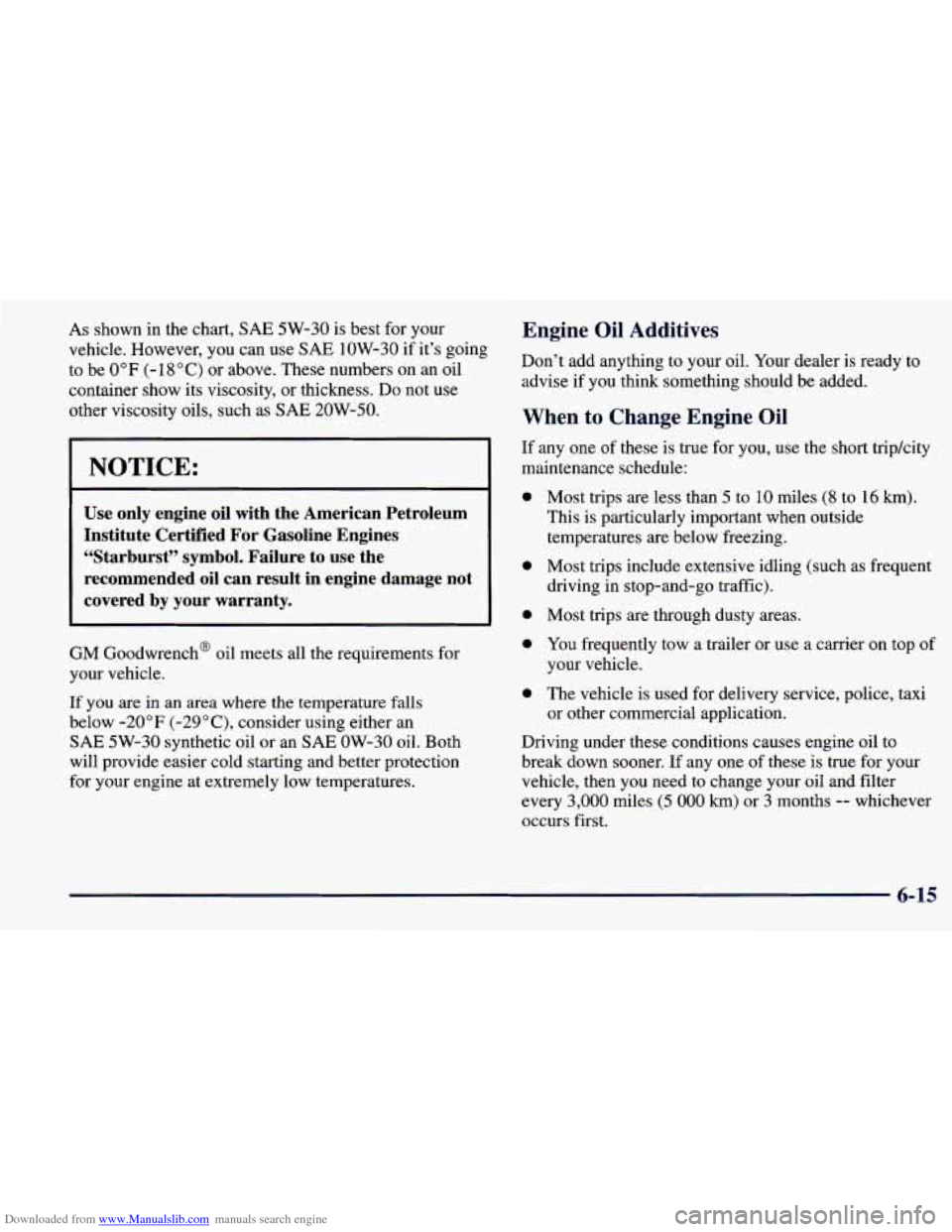
Downloaded from www.Manualslib.com manuals search engine As shown in the chart, SAE 5W-30 is best for your
vehicle. However, you can use
SAE 1OW-30 if it's going
to be
0" F (- 18 " C) or above. These numbers on an oil
container show its viscosity, or thickness.
Do not use
other viscosity oils, such as
SAE 20W-50.
NOTICE:
Use only engine oil with the American Petroleum
Institute Certified For Gasoline Engines
"Starburst" symbol. Failure to use the
recommended oil can result in engine damage not
covered by your warranty.
GM Goodwrench@ oil meets all the requirements for
your vehicle.
If you are in an area where the temperature falls
below -20°F (-29 "C), consider using either an
SAE 5W-30 synthetic oil or an SAE OW-30 oil. Both
will provide easier cold starting and better protection
for your engine at extremely low temperatures.
Engine Oil Additives
Don't add anything to your oil. Your dealer is ready to
advise
if you think something should be added.
When to Change Engine Oil
If any one of these is true for you, use the short tripkity
maintenance schedule:
0
0
0
0
0
Most trips are less than 5 to 10 miles (8 to 16 km).
This is particularly important when outside
temperatures are below freezing.
Most trips include extensive idling (such as frequent
driving in stop-and-go traffic).
Most trips are through dusty areas.
You frequently tow a trailer or use a carrier on top of
your vehicle.
The vehicle is used for delivery service, police, taxi
or other commercial application.
Driving under these conditions causes engine oil to
break down sooner.
If any one of these is true for your
vehicle, then you need to change your oil and filter
every
3,000 miles (5 000 km) or 3 months -- whichever
occurs first.
6-15
Page 244 of 364
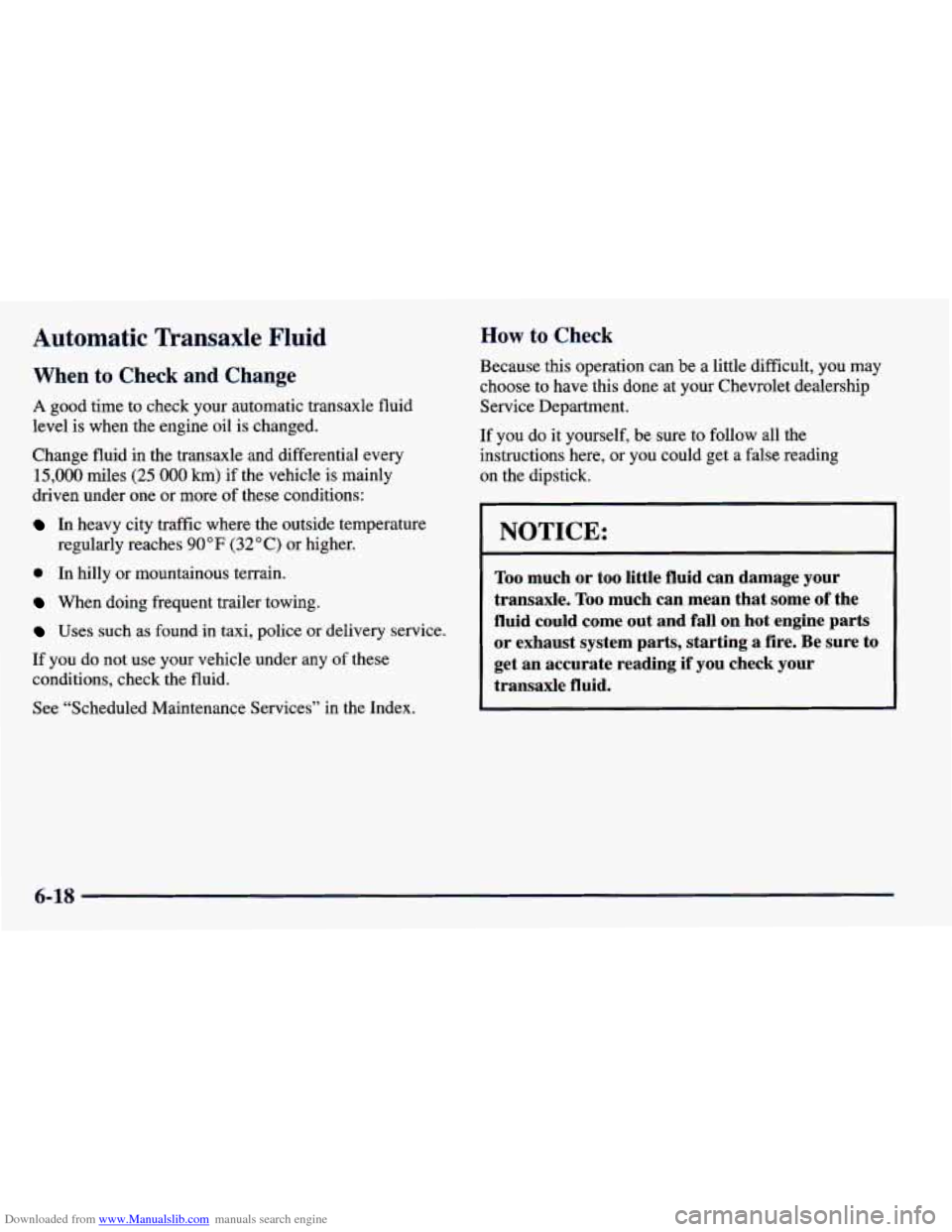
Downloaded from www.Manualslib.com manuals search engine Automatic Transaxle Fluid
When to Check and Change
A good time to check your automatic transaxle fluid
level is when the engine oil is changed.
Change fluid in the transaxle and differential every
15,000 miles (25 000 km) if the vehicle is mainly
driven under one or more of these conditions:
In heavy city traffic where the outside temperature
regularly reaches
90°F (32°C) or higher.
0 In hilly or mountainous terrain.
When doing frequent trailer towing.
Uses such as found in taxi, police or delivery service.
If you do not use your vehicle under any of these
conditions, check the fluid.
See “Scheduled Maintenance Services’’ in the Index.
How to Check
Because this operation can be a little difficult, you may choose
to have this done at your Chevrolet dealership
Service Department.
If you do it yourself, be sure to follow all the
instructions here, or you could get a false reading
on the dipstick.
I NOTICE:
Too much or too little fluid can damage your
transaxle.
Too much can mean that some of the
fluid could come out and fall on hot engine parts
or exhaust system parts, starting a fire. Be sure to
get an accurate reading if you check your
transaxle fluid.
6-18 .-
Page 249 of 364
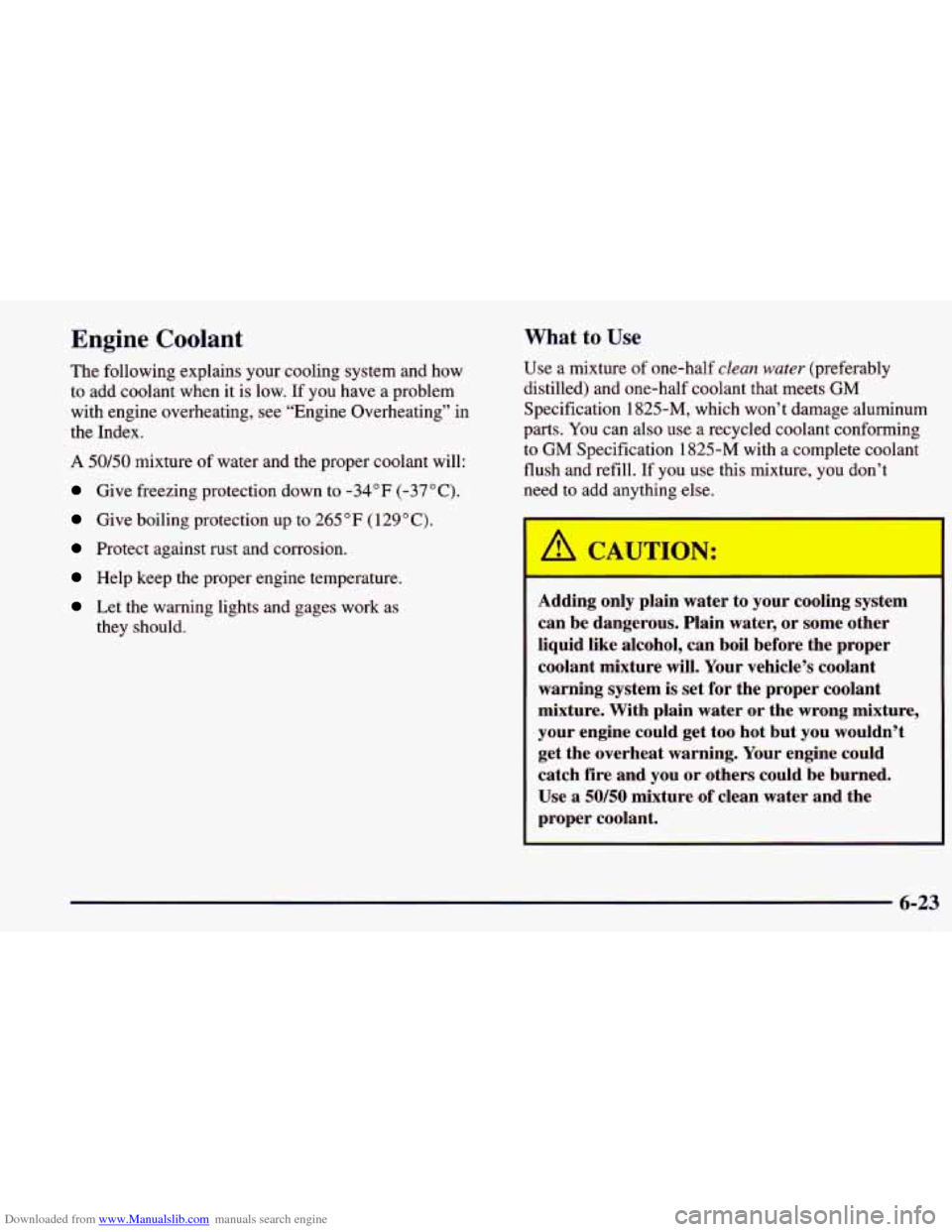
Downloaded from www.Manualslib.com manuals search engine Engine Coolant What to Use
The following explains your cooling system and how
to add coolant when it is low.
If you have a problem
with engine overheating, see “Engine Overheating” in
the Index.
A 50/50 mixture of water and the proper coolant will:
Give freezing protection down to -34°F (-37°C).
Give boiling protection up to 265°F (129°C).
Protect against rust and corrosion.
Help keep the proper engine temperature.
Let the warning lights and gages work as
they should. Use
a mixture of one-half
clean water (preferably
distilled) and one-half coolant that meets
GM
Specification 1825-M, which won’t damage aluminum
parts.
You can also use a recycled coolant conforming
to
GM Specification 1825-M with a complete coolant
flush and refill. If you use this mixture, you don’t
need to add anything else.
IC ION:
Adding only plain water to your cooling system
can be dangerous. Plain water, or some other
liquid like alcohol, can boil before the proper
coolant mixture will. Your vehicle’s coolant
warning system is set for the proper coolant
mixture.
With plain water or the wrong mixture,
your engine could get too hot but you wouldn’t
get the overheat warning. Your engine could
catch fire and you or others could be burned.
Use a
50/50 mixture of clean water and the
proper coolant.
6-23
Page 285 of 364

Downloaded from www.Manualslib.com manuals search engine Capacities and Specifications
Engine
Type .................................... L4
Compression Ratio ...................... 10.0: 1
Firing Order
.......................... 1-3-4-2
Fuel Delivery
........... Multi-Port Fuel Injection
Piston Displacement
.............. 109 CID (1.8L)
Valve Arrangement
........ Double Overhead Cam
Thermostat Temperature
........... 167°F (76°C)
Wheel Nuts
Wheel Nut Torque ........... 100 lb-ft (140 Nem)
Capacities (Approximate)
The following approximate capacities are given in
English and metric conversions.
Air Conditioning
.............. See the refrigerant
information label under the hood.
Automatic Transmission
3-Speed
.................. 2.6 quarts (2.5 L) **
4-Speed .................. 3.3 quarts (3.1 L) **
Differential (3-speed only) ...... 1.5 quarts (1.4 L)
Manual Transaxle ............ 2.0 quarts (1.9 L)**
Cooling System
Manual Transaxle
.......... 6.6 quarts (6.2 L)
Automatic Transaxle .......... 6.4 quarts (6.1 L)
Fuel Tank ................... 13.2 gallons (50 L)
Engine Oil (Change w/ Filter*)
... 3.9 quarts (3.7 L)
* When changing the oil filter, additional oil may
be needed. Recheck the oil level after filling. See “Engine Oil” in the Index.
** Recheck fluid level after filling. See “Automatic
Transaxle Fluid” or “Manual Transaxle Fluid”
in
the Index.
6-59
Page 291 of 364

Downloaded from www.Manualslib.com manuals search engine Maintenance Schedule
I Short Trip/City Definition I
Follow the Short TripKity Maintenance Schedule if any
one of these conditions is true for your vehicle:
0
0
0
0
0
Most trips are less than 5 to 10 miles (8 to 16 km).
This is particularly important when outside
temperatures are below freezing.
Most trips include extensive idling (such as frequent
driving in stop-and-go traffic).
Most trips are through dusty areas. You frequently tow a trailer or use
a carrier on top of
your vehicle.
If the vehicle is used for delivery service, police, taxi
or other commercial application.
One of the reasons you should follow this schedule
if you operate your vehicle under any of these conditions
is that these conditions cause engine oil to break
down soonez
Short Trip/City Intervals
Every 3,000 Miles (5 000 km): Engine Oil and Filter
Change (or
3 months, whichever occurs first).
Every 6,000 Miles (10 000 km): Chassis Lubrication
(or
6 months, whichever occurs first). Tire
Rotation. Air Cleaner Filter Inspection,
if driving
in dusty conditions.
Every 15,000 Miles (25 000 km): Automatic Transaxle
Fluid Change (severe conditions only). Automatic
Transaxle Fluid Check (normal conditions).
Every 30,000 Miles (50 000 km): Air Cleaner Filter
Replacement. Spark Plug Replacement. Fuel Tank,
Cap, Cap Gasket and Lines Inspection (or every
24 months, whichever occurs first). Manual Transaxle
Fluid Change (severe conditions only) (or every
24 months, whichever occurs first). Cooling System
Service (or every
24 months, whichever occurs first).
(Continued)
7 -5
Page 296 of 364

Downloaded from www.Manualslib.com manuals search engine I Short Trip/City Maintenance Schedule I
12,000 Miles (20 000 km)
0 Change engine oil and filter (or every 3 months, whichever occurs first).
0 Lubricate chassis components (or every 6 months, whichever occurs first).
0 Rotate tires. See “Tire Inspection and Rotation” in the Index for proper
Inspect air cleaner filter if you are driving in dusty conditions. Replace
An Emission Control Service.
(See footnote #.)
rotation pattern and additional information. (See footnote +.)
filter if necessary.
An Emission Control Service. (See footnote ”f)
15,000 Miles (25 000 km)
Change engine oil and filter (or every 3 months, whichever occurs first).
An Emission Control Service.
0 Change automatic transaxle and differential fluid every 15,000 miles
(25 000 km) if the vehicle is mainly driven under one or more of
these conditions:
- In heavy city traffic where the outside temperature regularly reach\
es
- In hilly or mountainous terrain.
- When doing frequent trailer towing.
- Uses such as found in taxi, police or delivery service.
If you do not use your vehicle under any
of these conditions, check the fluid.
90°F (32°C) or higher.
DATE I
MILEAGE
DATE
I
MILEAGE
Page 301 of 364
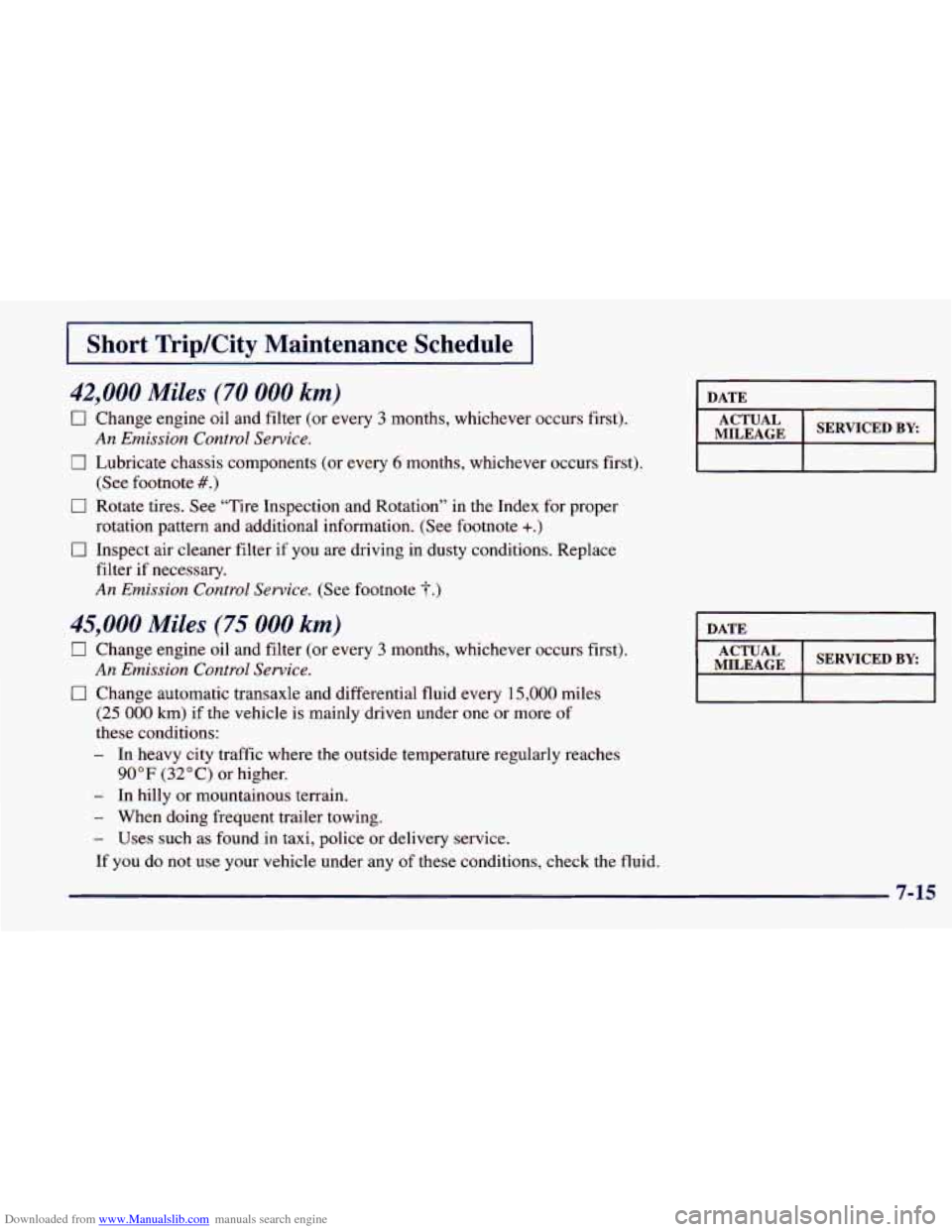
Downloaded from www.Manualslib.com manuals search engine I Short TripKity Maintenance Schedule I
42,000 Miles (70 000 km)
0 Change engine oil and filter (or every 3 months, whichever occurs first).
0 Lubricate chassis components (or every 6 months, whichever occurs first).
0 Rotate tires. See “Tire Inspection and Rotation” in the Index for proper
An Emission Control Service.
(See footnote #.)
rotation pattern and additional information. (See footnote +.)
0 Inspect air cleaner filter if you are driving in dusty conditions. Replace
filter if necessary.
An Emission Control Service. (See footnote T,)
45,000 Miles (75 000 km)
0 Change engine oil and filter (or every 3 months, whichever occurs first).
An Emission Control Service.
0 Change automatic transaxle and differential fluid every 15,000 miles
(25 000 km) if the vehicle is mainly driven under one or more of
these conditions:
- In heavy city traffic where the outside temperature regularly r\
eaches
- In hilly or mountainous terrain.
- When doing frequent trailer towing.
- Uses such as found in taxi, police or delivery service.
If you do not use your vehicle under any of these conditions, check the fluid.
90°F (32°C) or higher.
DATE I
7-15